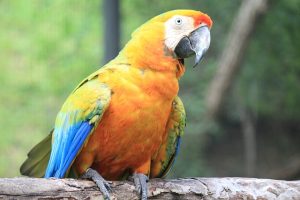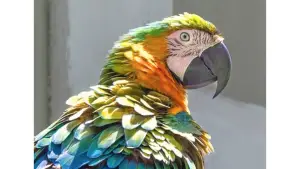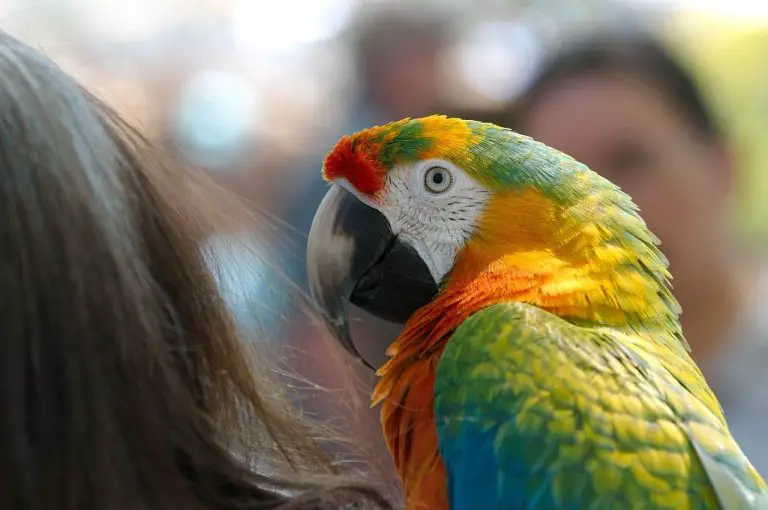The Catalina Macaw probably doesn’t come to mind when you think of unique and rare birds. With an estimated wild population of less than 800, these beautiful parrots are not exactly hard to find in abundance. Thankfully, the Catalina Macaw is one of the most common and easily spotted parrots in its natural habitat. Even so, this beautiful blue bird with a yellow beak remains an uncommon exotic pet. Like all parrots, Catalina Macaw is messy, loud, and destructive.
Their name doesn’t come from any particular place; it’s just where they are commonly found. Besides their unique appearance, what do you know about these avian creatures? Why are these birds called ‘Macaws’? Let’s take a closer look!
Brief history and origin of Catalina Macaw

The Catalina macaw is named after the Catalina Bird Park on Santa Catalina, where it was first bred in 1940. It is a first-generation cross of the blue-and-yellow Macaw and the scarlet Macaw. Catalina macaws lack a scientific name since they are hybrids. In taxonomy, these birds are best represented by the phrase Ara ararauna Ara Macao.
Macaw hybridization can occur in captivity. However, the majority of Catalina macaws are the consequence of selective breeding. As a result, they are rarely found in the wild on their own. The blue-and-gold Macaw is known for its attitude, whereas the scarlet Macaw is known for its beauty.
This mix has resulted in the sought-after Catalina macaw with its vibrant coloring. The father’s genes are dominant in bird breeding. As a result, the male scarlet Macaw is usually distinct from the female blue-and-gold Macaw.
Breeding two Catalina macaws together can also result in a second-generation hybrid. A well-balanced diet contains a wide range of seeds, vegetables, fruits, and nuts. Apples, pears, cherries, grapes, bananas, mangoes, papayas, and berries are all for feeding. Good vegetables are carrots, sweet potatoes, cucumbers, zucchini, and leafy greens.
Types of Catalina Macaw Hybrid
Hybrid macaws result from cross-breeding between two or more macaw species. They are widely bred for their coloration, so they are sought after in the pet trade. Catalina Macaw Hybrids are mainly classified as follows:
Camelina Macaw
The camelina macaw is a cross between the Camelot and Catalina macaws. The Capri Macaw is a third-generation hybrid macaw with a lot of Scarlet Macaw in its ancestry. The Camelina Macaw has been a well-known South American parrot for nearly a century. It is one of the most well-known macaws for its beautiful coloration. It has primarily yellow wings with green and blue borders.
Camelot is one of the parents of the second-generation hybrid macaw and is in the third crossing. The Camelina Macaw is 7/8 ancestry from the Scarlet Macaw, which affects the qualities of this species.
Catablu Macaw
Catablu is a colorful hybrid macaw who is clever and lively. Unfortunately, by the time the baby is ready for his new home, he has been completely socialized and tamed. The Catablu’s personality crosses the Blue & Gold Macaw and the Catalina Macaw. They have the amiable nature of the Blue & Gold, which softens the Catalina macaw attitude.
They are incredibly clever and eager to learn and may become excellent communicators. Catablu Macaw’s wings are primarily yellow with a green and blue border.
Militalina Macaw
The Militalina Macaw is a hybrid between the Hyacinth Macaw and the green Military Macaw. This combination produces an extremely deep and uncommon blue-green.
The behavior of hybrid macaws is more variable and uncertain than their color. The soft, quiet attitude of the Hyacinth Macaw is present in Militalina Macaws. They may be friendly and huggable, and they like interacting with one or more people and other birds.
Quickness to learn tricks are traits they can acquire from the Military Macaw side. You may have an intelligent and caring pet with each of these characteristics. This is a hybrid; they were not bred, but hybrid breeding is becoming prevalent.
Hyalina Macaw

The Hyalina Macaw is a mix between a hybrid Catalina Macaw and a Hyacinth Macaw, making them hybrid macaws of the second generation.
Hyalina Macaws, like their parents, may be excellent “talkers.” When they are young, they are likelier to others if both sexes handle it. The Hyalina Macaw’s wings are primarily red with a green and blue border.
Rubalina Macaw
The Rubalina Macaw is a hybrid cross between the Ruby and Catalina Macaws (hybrid).
Being a hybrid between a Ruby and a Catalina provides this unique Macaw with a wide range of colors. It is a second-generation hybrid affected by the DNA of three separate macaw species.
Each Rubalina is a one-of-a-kind color combination inherited from its parents. Their wings are predominantly orange with green, yellow, and blue borders.
Camelot Macaw
The Camelot Macaw inherited a lot of Scarlet Macaw DNA from its parents. As a result, the Scarlet Macaw has been the most well-known South American parrot for nearly a century.
It is one of the most popular macaws, characterized as “beautiful and striking.”
The Camelot inherits all of that lovely colors and more! Both parents affect the qualities and characteristics of offspring. The attitude and conduct are more variable.
A Scarlet’s nature needs solid socialization and a hand in training as it develops. The Camelot can have these features, as well as the kind attitude and speaking skills of the Blue and Gold Macaw. It may be a highly loving, curious, and entertaining pet.
Shamalina Macaw
The Shamalina Macaw is a mix between the Shamrock and Catalina Macaws.
Shamalina is historically bred for color. As a result, attributing personality traits to a hybrid is a component that is yet unclear. This bird has a good chance of being a fair talker with four distinct grandparents. It may also have a pleasant temperament due to Macaw’s kind, sensitive personality.
Both the Shamrock Macaw and the Catalina Macaw have friendly personalities. But, if the Shamalina Macaw temperament is present, it may need constant training.
The names of the hybrid macaws are drawn from physical characteristics like color. Also, they are from the name of a person or region where they originated. A name is often used by one person, then others, until acknowledged as the standard common name.
Flame Macaw
Color is widely bred into hybrid macaws, and the Flame Macaw has impressive coloring. This Macaw is a hybrid macaw of the second generation. The Flame macaws originate from the Catalina Macaw, the offspring of two macaws.
The Blue and Gold Macaw, the other parent, is one of the most popular pet birds in the trade. Renowned not only for its beauty but also for its sweet nature and speaking ability.
The ‘gentle giant’ Green-winged Macaw was added to the Catalina mix. The Flame Macaw inherits all these other macaws’ coloration and a complex personality!
Because fathers carry the dominant gene, their color and look are all influenced. However, attitude and conduct are more variable. The Flame Macaw’s ancestry is an unusual combination for a pet bird. However, this hybrid parrot is appealing due to its parents’ intellect.
It should be trainable, capable of talking and performing stunts, and friendly. But, on the other hand, the fiery Scarlet may provide an invincible spirit. The Flame Macaw, like other macaws, will need socializing and firm, hand in training as it develops.
Maui Sunrise Macaw

The Maui Sunrise Macaw combines a Harlequin Macaw and a Catalina Macaw (hybrid). Being a mix between a Harlequin and a Catalina provides it with a wide range of colors and personalities. It is a second-generation hybrid affected by the DNA of three separate macaw species.
The Maui Sunrise is a second-generation hybrid macaw with a lot of Blue and Gold Macaw in its ancestry. The Blue and Gold Macaw is one of the most popularly bought pet birds. Recognized not only for its beauty but also for its gentle ability to communicate.
Two more species also contribute to the taste. The Green-winged Macaw contributes both beauty and a pleasant personality. The Scarlet Macaw is one of the most popular macaws, with a rich red coloration. The Maui Sunrise inherits all of these lovely birds’ coloration and more.
Milicat Macaw
The Milicat Macaw is a hybrid of a Miligold Macaw (hybrid) and a Catalina Macaw (hybrid). The attitude and behavior of hybrid macaws are more uncertain than their color. Milicat Macaws are hybrid parrots appealing due to their parents’ intellect.
Milicats should be trainable, able to converse and do tricks, and have a friendly demeanor. In addition, these ladies may be pretty loving, curious, and entertaining companions. They, like other macaws, will need socialization and training to make ideal pets.
FAQs
Is Catalina macaw friendly?
Catalina Macaws are generally amiable and easygoing. Catalina macaws fall in the middle: they are kinder and cleverer than blues and golds. They, like any other macaw, may be trainable to speak.
Can Catalina macaw reproduce
Because all macaws are monomorphic, it is difficult to tell a male from a female without testing. Breeding two Catalina macaws together can also result in a second-generation hybrid.
How much does Catalina macaw cost
Catalina macaws price between $3,000 and $5,000 by breeders.
What is the lifespan of a Catalina macaw?
In captivity, the typical Catalina can live for up to 60 years.
Conclusion
If you’re looking for a bird that’s easy to care for and relatively low maintenance, then the Catalina Macaw might be the perfect fit.
These birds are known for having a sweet, soft voice and are relatively low-key, making them great companions for people who are busy or work long hours. If you’re interested in owning a Catalina Macaw, be sure to do your research before visiting a breeder.

Hi, I’m Regina Rios. Just another bird lover who loves to share knowledge from personal experience. I’ve grown up with pet birds since childhood as my mommy also loves birds. As I can’t pet many birds in open air in my house as my mom does; I created my first bird cage on my rooftop using wood, copper wire, and a metal shed in 2018 and start collecting pet birds. Now, I have so many pet birds such as Macaws, Parrot, Cockatiel, Parakeet, and others. Not only that, if I see natural birds are injured I keep them in my house until they get well. Now, my hobby becomes my income source as my home birds have babies and I sell them to birds lover like mine. I’ve created this blog to inspire others bird owners by sharing my personal knowledge. Good Luck!


